Content creators have some of the most valuable skills in the online world.
Whether you want to create content for yourself or for others, a content creator can do what few people can: tell stories, persuade people, and build a following of loyal readers.
The benefits a company can get from such skills are invaluable. Sadly, many content creators take a “write-for-fun” approach that limits the chances they have to make a living from their skills.
If you want to know how to become a freelance content creator that enchants people with your writing, then in this guide I will show you the five skills you need to develop.
Let’s jump right into it.
⚠️ This article is over 6,000 words. Download a summary of this article.
What Is a Content Creator? A Definition
A content creator is someone who delivers written or multimedia content (like audio or video) in both the online and offline worlds.
In a broad sense, a YouTuber, an Instagram influencer, and a writer like myself are all content creators. In this guide, however, I will focus on writers who are also content creators—people like myself, that is.
While a journalist or a blogger creates content for professional needs or for the sake of it, a content creator has a narrower intent to engage and persuade their audience.
Become a Master Mind Reader
Have you ever noticed that some writers seem to create content that always hooks with people? What these content creators do differently is that they’re master mind readers.
By mind reading, I refer to the ability they have to research, analyze their topics, and come up with content ideas that connect with their audience as soon as they hit the “Publish” button.
The idea of publishing a topic because it makes you feel right is an amateur mistake you need to get rid of. Every piece you ever create must have a clear purpose; not to sell or drive page views, but to satisfy a need of your audience.
Developing mind-reading skills is no “voodoo” secret; it only takes the right approach. Here are three ways you can start reading the minds of your audience.
Follow Trends
I like to think of trends as the “path of least resistance;” the hidden force that can help you connect with people on a scale without having to fight for their attention.
The goal of following trends is to create content around the topics people already consume and like.
Since you can’t know with complete accuracy the topics people read—you’d need to spy on your competitors’ analytics, which is sort of illegal 😅—you can use inbound links, shares, and comments as a proxy for popularity.
Two tools you can use for such purposes are Buzzsumo and Ahrefs. Both tools allow you to see what articles people share in the main social media channels.
Here’s a shortlist of the most shared articles around the subject of low carb dieting according to Buzzsumo:
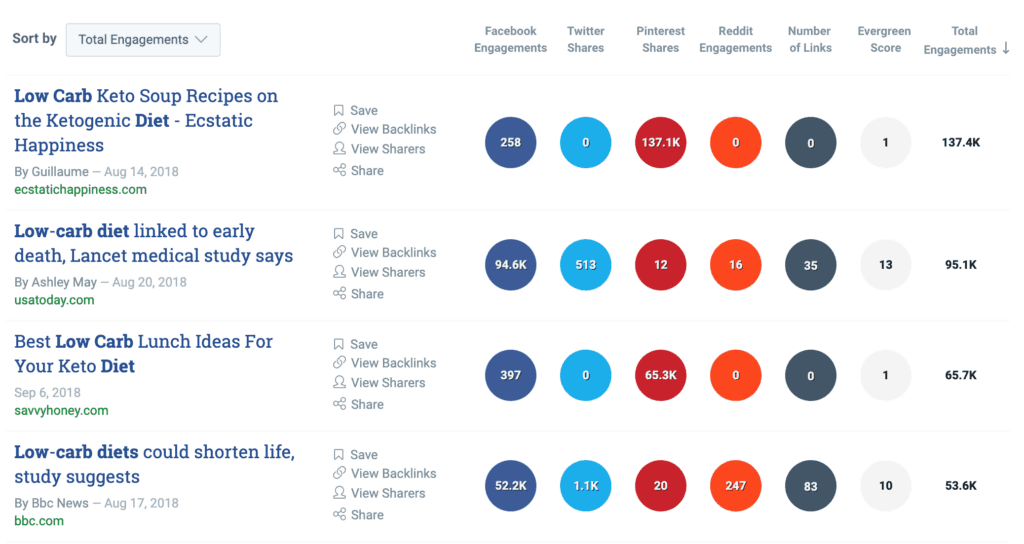
These posts are incredibly popular, all of them with more than 50,000 shares (!). You can see that three posts are around the same study that link the positive effects of a keto diet, while the other two are a mix of recipes.
Here’s the same topic analyzed in Ahrefs:
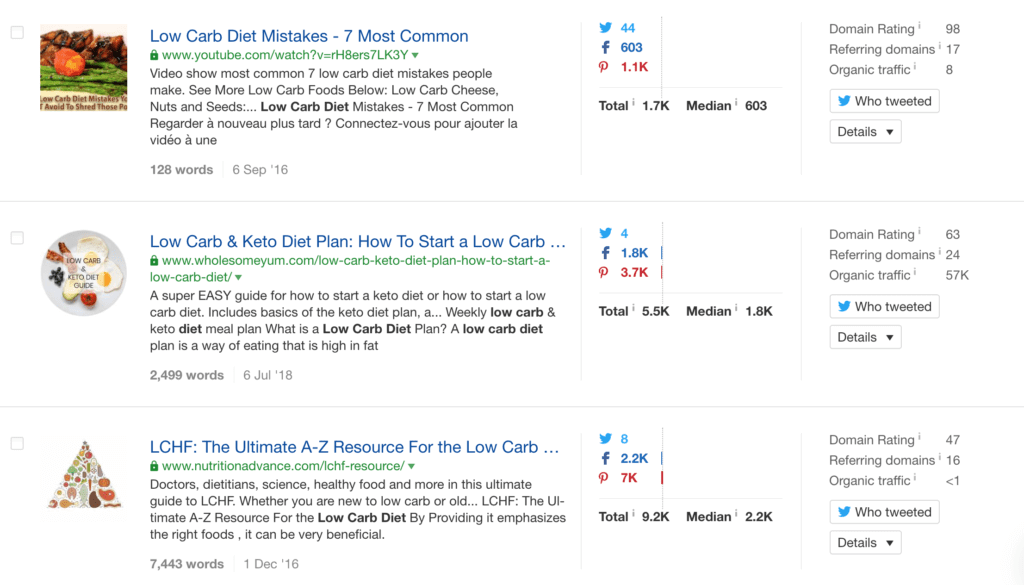
I’ve said before Ahrefs is one of my favorite SEO tools. While their content explorer isn’t as good as Buzzsumo’s, it’s still pretty good to give you another look at the articles people share. The double analysis will help you triangulate the best topics and trends in your industry.
Despite its limitations, ahrefs offers a deeper set of features that allow you to find keywords (which you will see in the next point) and analyze backlinks, something that can help you in your link building efforts—a critical part of your content promotion campaign.
If you click on the “Details” button you will see the entire link analysis of each post.
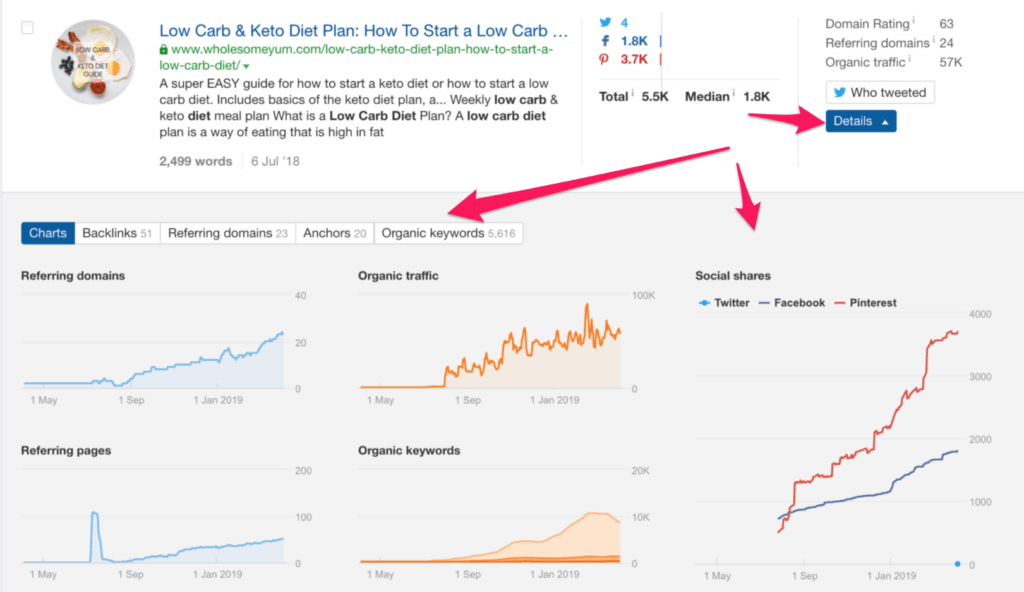
A more manual and granular approach to find industry trends is to create a list of sites that are the most popular in a given industry and follow them. You can use a tool like Flipboard or Feedly which helps you create an RSS feed that gives you the latest articles published in any site you want.
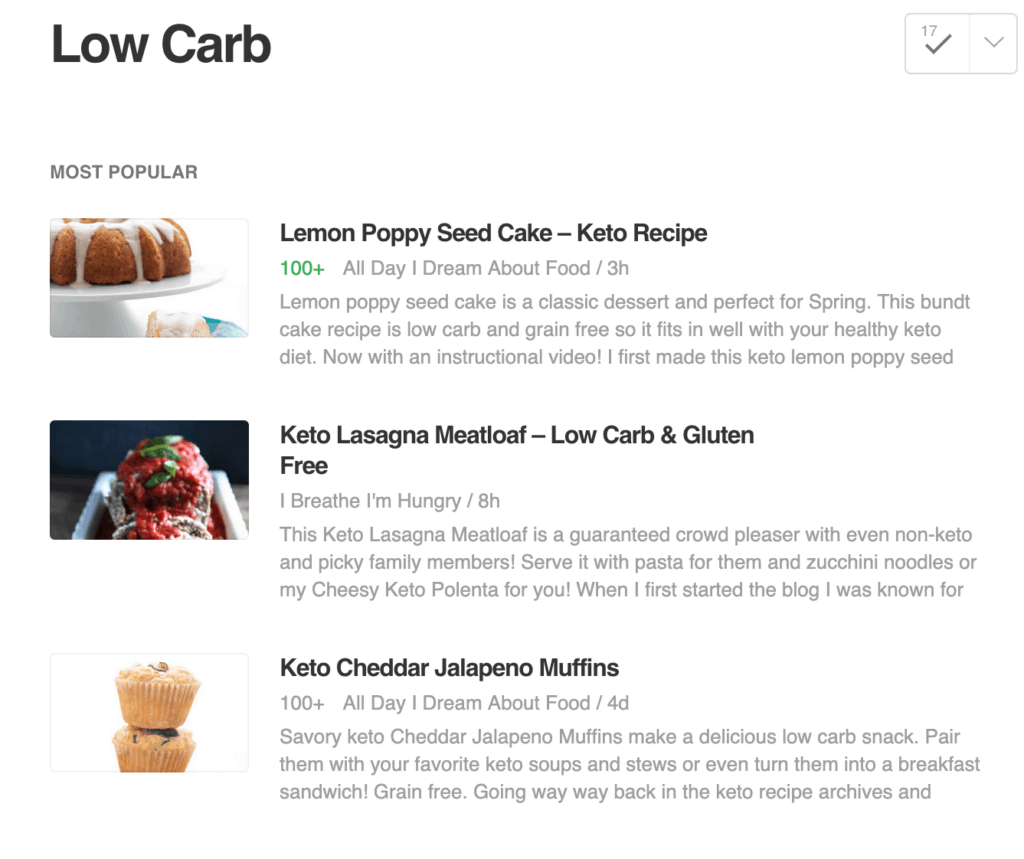
Such an approach will take much more time, but in the long term, it will be the most ideal, as trends develop slowly. A one-time analysis with BuzzSumo or Ahrefs will give you a snapshot of the present, not a long-term analysis of your industry.
Unlike what some content creators think, trend following doesn’t mean you need to create yet another piece on a topic widely covered. Rather, you want to get inspired by these topics and give a new spin to a vetted idea.
In the low carb diet example, you can see most people often talk about recipes, but Buzzsumo’s analysis shows you that there’s also a lot of interest in the scientific results of such diet.
With this insight, you could add a spin to the traditional recipe-focused approach and make a post about scientific-based low carb recipes.
Scout Forums
Marketers have a mantra that says you need to market an offer “where your target audience hangs out.”
This idea is beautiful on its simplicity: if you want to sell shoes, go where shoe lovers go to, like fashion events and the like.
While in the offline world you need to take a “spray-and-pray” approach, like buying a billboard that everyone—both your target audience and otherwise—can see.
In the online world, fortunately, the situation is much easier. Two widely popular sites that involve thousands of different communities are Reddit and Quora.
The former is like a forum of forums, where communities as varied as parachuting, candy, and shoemaking intersect. Many of these forums (called “subreddits”) are extremely popular, massing hundreds of thousands of people in them.
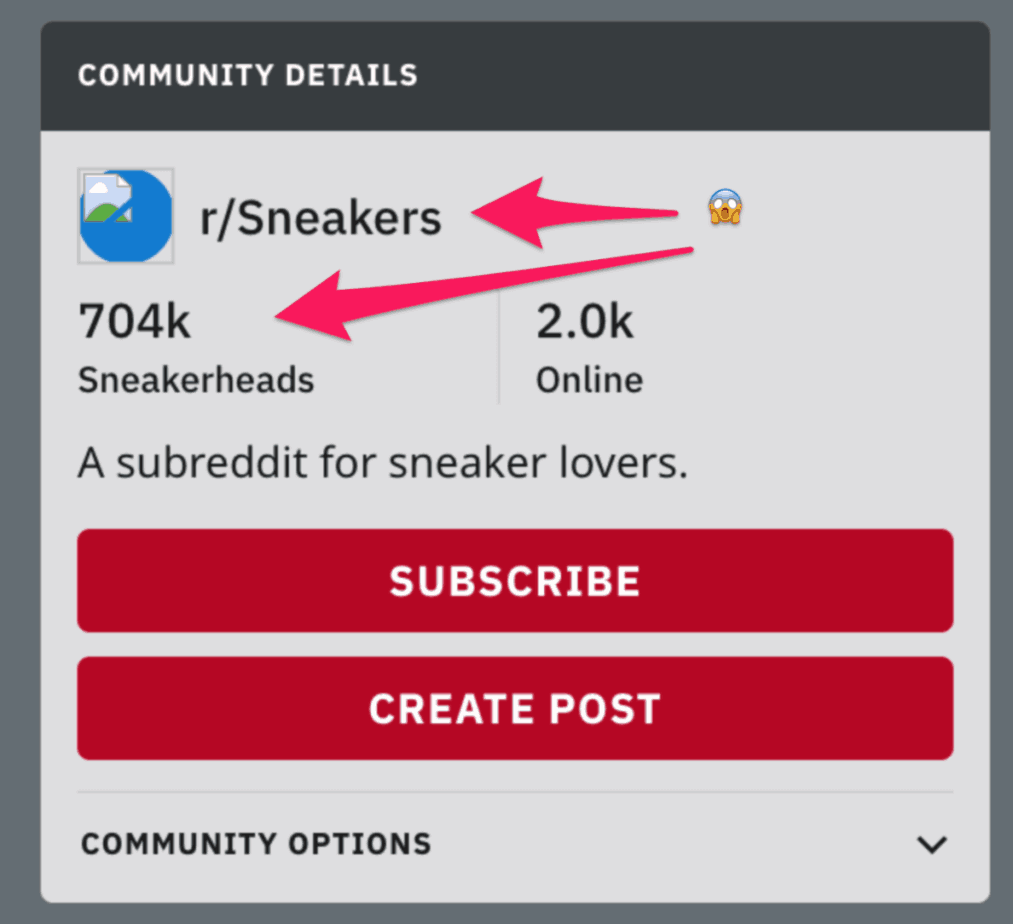
Quora works similarly, except that instead of creating a post, you ask a question or answer one.
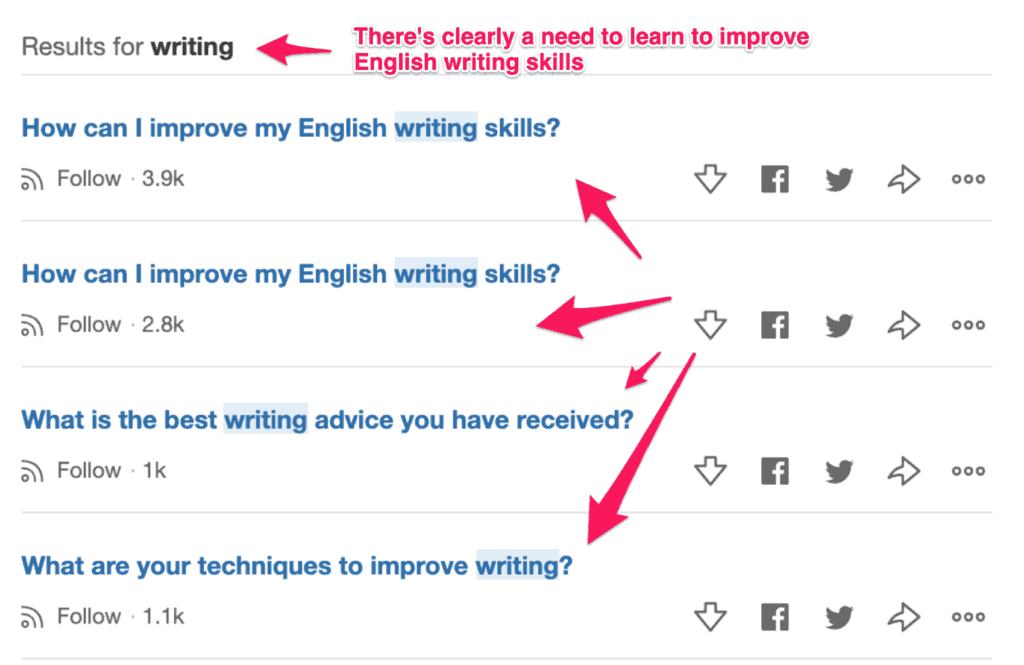
In both sites, you can find a large number of ideas, problems, situations, and questions people have around a given industry as you saw above around the topic of writing.
One of my favorite places to uncover deep pains from entrepreneurs is the /r/Entrepreneur subreddit. I’ve found countless juicy questions people in this niche have that has helped me get inside their heads in ways no keyword research would have ever allowed me to do.
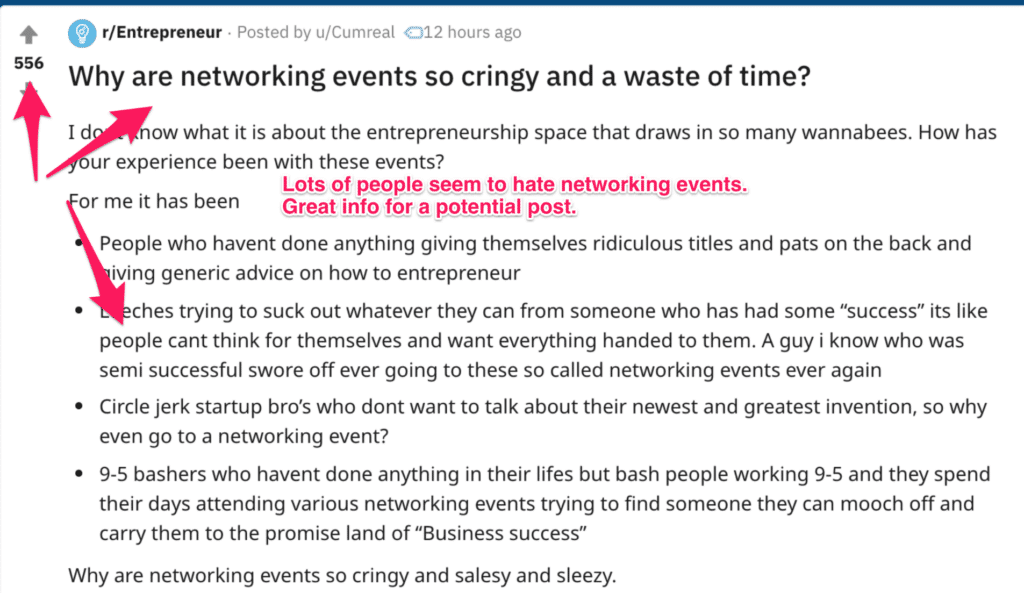
The key to mind reading people on either site is to look beyond the obvious and read between the lines. In the example above, I can see that lots of people seem to agree with the points the OP (the individual who created the post) mentions, like networking events being sleazy and full of leeches.
If I was to write a post on the subject, I could take those comments and the ones people shared within the post to get a much deeper idea of what people think on the subject. These insights would help my post become much more realistic and personal; it’d make my readers think “wow, how did he make this post so like me?“
By scouting forums, that’s how.
Carry Out Keyword Research
Keyword research is a data-driven way of finding the type of queries people search in the search engines (including Amazon and YouTube).
Just like a Quora question is a proxy for a deeper problem, a query represents an opportunity to see the information people look for.
Many SEO experts will tell you that your goal is to find lots of high volume ideas with the lowest difficulty possible. While there’s some truth to this, the key isn’t to focus exclusively on the actual search volumes, but on the intent.
Once again, think about the intent the searcher had when typing a query. If you find people search for “how to get fit for summer,” this says a lot about them. You could come to many conclusions, like that:
- These people feel that they need to lose weight only for a period of the year
- These people are overweight
- These people are in a hurry
- These people focus on deadlines
- These people lose control of their eating habits throughout autumn and winter
You will need to research for many keywords to get such good ideas.
The best keyword research toolbar none is Ahrefs. It’s the most complete and detailed of all the keyword research tools out there. While some of its estimations aren’t that good, that tool has been behind all of my content marketing campaigns for the past two years.
It’s why I’ve been able to rank high for high-traffic keywords like “nike marketing strategy” (over 1000 monthly searches) or “writing techniques” (over 6000 monthly searches) in just a few weeks.
Let’s say you wanted to create a post that helped entrepreneurs get funding. You’d put “startup funding” in ahrefs’ research engine and you’d see the results it would create for you.
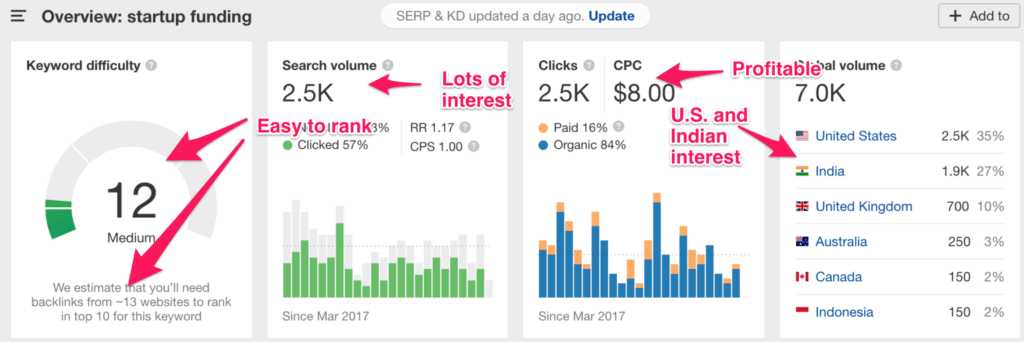
In this screenshot, you can already see that this keyword is highly popular and quite expensive (CPC of $8.00, which means people are willing to pay that amount for every click to their site). If people pay that much for this keyword, it means they can somehow make money from it.
You can also see that’s it’s easy to rank, and most of its interest comes from the US and India.
On its own, that’s a lot of useful data—you can expect to get a few hundred visitors per month from this keyword if you can rank it in the top 5 results.
Scroll down a bit more, and you will see a long list of “keyword ideas.”
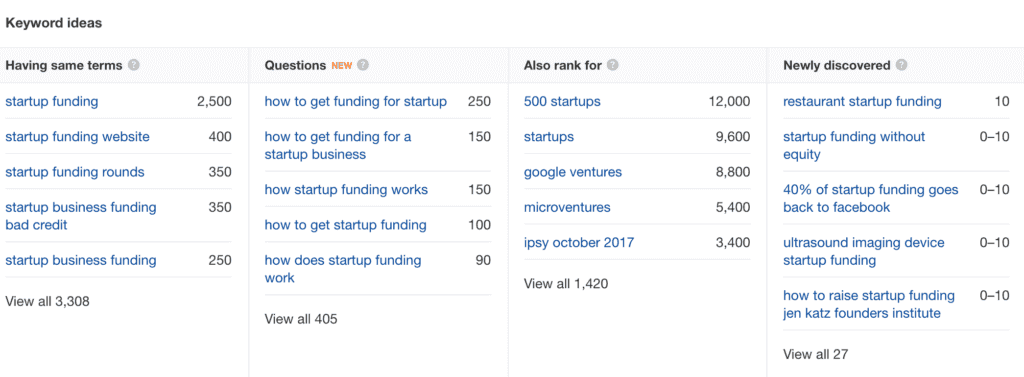
You can open each of these four lists and see what else you find. Most of this data comes from Google’s results, like the “People also ask” box.
Because this keyword is so broad—people may be looking for information to get funding while some others may want to learn how the whole process works, two very different audiences—it’s best you get a feeling of the intent behind it.
Google wants to rank the pages that best serves their interests—that is, the pages that are the closest to the intent of its users—so check the top 10 results for all the keywords you find and see what you find.
In the “startup funding” keyword, you can see the top 10 results are mostly around how to get funding.
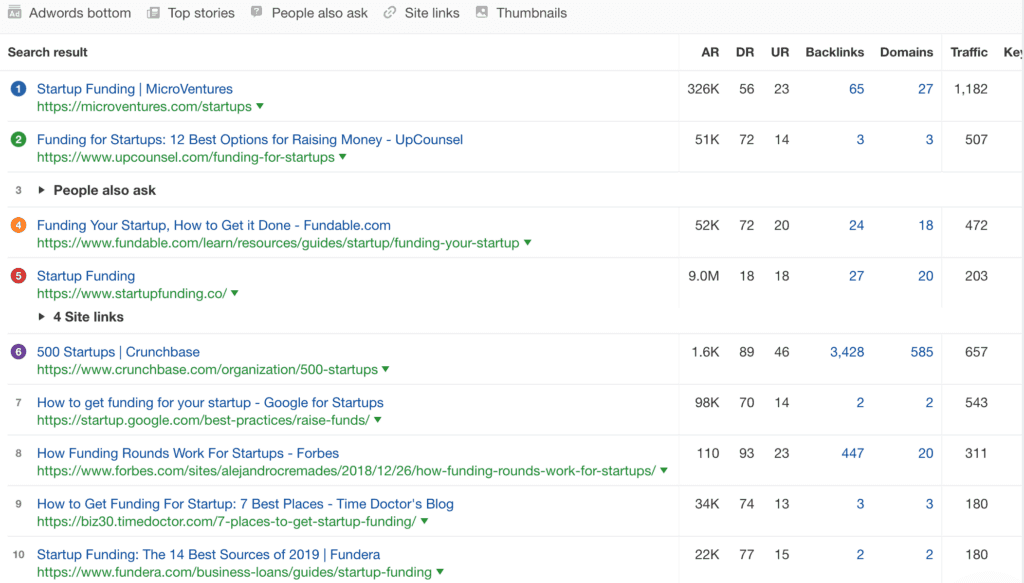
That means, there seems to be a lot of interest around that topic, so your content should be close to that idea and not, let’s say, how it works or the history of startup funding.
The most effective way to read the minds of your audience is to combine all of these three methods. One will show you what people search, another will tell you what they share, and another will tell you what they talk about.
Different subtleties that give you a much more precise idea of the thoughts your audience has.
Remember: None of these tactics are great on their own; each one shows a different part of your audience’s needs and interests.
Use all of these tactics to get inside their mind so whenever you publish a new piece, it speaks to them.
Because when your content “clicks” with your audience, it’s when you can become truly persuasive.
Master Grammar
Grammar is paramount to the success of a freelance content creator; it’s what separates amateur bloggers from professional word craftsmen.
You don’t have to take a course on grammar to master it, or read an entire dictionary, or go back to your high school notepad.
There are only a few key aspects of grammar you need to grasp so you can master it.
I already explained the majority of them in my article on grammar mistakes, but since that’s already a long guide, let me share with you a cliff’s notes of the most important grammar ideas you must improve.
Learn Your Punctuation
Punctuation is one of the most overlooked elements of grammar for the simple fact it’s really obvious.
You’d hardly think you need to learn how to use a full stop, an em-dash, or a semicolon; you’re already old enough to know that.
Sadly, I see time after time what otherwise would be great pieces of content get ruined by its incorrect punctuation marks.
You can see your punctuation as a tool to organize your ideas and give them structure, rhythm, and meaning.
It’s one thing to write “You need to write every day,” and another to write “You need to write. Every. Day.”
The former sentence seems helpful yet innocent; the latter highly authoritative, as if I was urging you to do it. I imagine a kind librarian saying the former, while I imagine an army’s officer saying the latter.
There are a lot of punctuation marks to learn, the most important ones being the commas, semicolons, em-dashes, and full stops.
Since I already wrote a lot about these punctuation marks, let me just remind you when you use them:
- You use a comma when you:
- List ideas
- Make a small clarification
- Make an introduction to an idea or subject
- Have two independent clauses united by a conjunction like “and” or “or”
- You use a semicolon when you:
- Have two related independent clauses
- You use an em-dash (the longest dash there is) when you:
- Want to amplify or clarify an idea
- You use a full stop when you:
- Want to separate two independent clauses altogether
- Want to give a dramatic effect to an idea, like I did a few paragraphs before
There are cases when you will be tempted to use a comma when you have to use a semicolon, or an em-dash when you want to use a comma, so the best advice I can give you to improve your punctuation is to develop a keen eye for your punctuation whenever you edit your content.
Vary Your Adjectives and Verbs
Unless you are an English major graduate or a professional journalist, you most likely use the most commonly known list of adjectives and verbs to describe and give action to your ideas.
When you’re getting started, using a small variety of adjectives and verbs can be acceptable; after a while, it won’t.
There are more powerful and precise ways of expressing yourself than using the superlative “very” or using cliché descriptions like “great” and “really useful.“
A good first way to widen your language is to read a lot, especially non-fiction, from authors who’re highly known for their quality work.
Authors like Steven Pinker, Nicholas Nassim Taleb, and Malcolm Gladwell will introduce you to a language that’s both entertaining and extensive; all of which will help you gain new methods of expression.
You also need to start making use of dictionaries. No, I’m not asking you to read a dictionary for fun—I’ve not gone that crazy yet. 😅
Rather, you need to use a tool like Power Thesaurus to help you find synonyms for common words.
With such a tool, your language will slowly start to change:
- “Very important” will become “essential,” “key,” or “critical”
- “Good” will become “excellent” or “proper”
- “Love” will become “appreciate,” “adore,” or “enjoy”
These are subtle changes that will give a much serious and rich sense to your writing.
Use Active, Well-Structured Sentences
The active voice is the best writing voice you can use to develop your content; one that conveys authority and clarity of thought. For that reason, I recommend you always use the active voice.
like to think of the active voice as if you were standing in a theater, speaking to a large audience. It makes you look authoritative, smart, and experienced.
The passive voice, in contrast, looks like you’re victimizing the object. It looks abstract and powerless—weak and sad.
Unless you want to give the subject of a sentence a weak position in relation to the verb—which is the whole idea behind the passive voice—avoid the passive voice and use the active one.
As I always like to say, a content writer must always look authoritative, and such effect is subtle. You can’t command random ideas to people; rather, you need to act and write in a way that you look like you know what you’re writing about (that’s if you do your research properly).
What’s more, limit the use of gerunds (the “-ings”). In the first sentence from this section, I could have written: “writing in the active voice is useful.”
But gerunds look weak. It looks like you’re moving as you write; as if you were speaking to a friend while you walk down the hall of your college campus. Gerunds have a place in your sentences, but often isn’t at the beginning of sentences or when you want to convey an important message.
Finally, as I also stated in the first sentence of this section, use the “noun + verb” structure. That means, start a sentence—especially those that start a paragraph or section—by putting the main object or noun, and then the verb upon which the former acts.
For example, in the first sentence of this section, I said: “The active voice is the best writing voice you can use to develop your content.” If you analyze that, it’d look like:
- Noun: The active voice
- Verb: is
A basic sentence, indeed, but one that’s clear and looks authoritative.
You can also use the “verb + noun” structure if you want to sound imperative, but if you use it too often, you will appear like an army officer instead of a gentle author; you will be too aggressive.
For example, if you reframed the first sentence of this section with the “verb + noun” structure, this is how it’d look like:
Use the active voice to develop your content.
Sure, it’s a good sentence, but a bit too harsh, don’t you think? After a while, your reader will feel like he’s being pushed around too much, so be careful with that structure. Use it sparingly, when you want to convey the most authority you can and impact the reader the most.
Check Your Grammar with Grammarly
If you want to improve your grammar immediately, then you need to check out Grammarly.
With Grammarly, you can easily take all your content pieces—essays, landing pages, sales pages, and articles—and edit them to improve their punctuation, adjectives and verbs usage, and active voice usage.

All you have to do is copy and paste your content into Grammarly’s web editor or native app and let it tell you want to improve. For a full analysis of this tool, please check my Grammarly review.
Follow their tips and you will improve your grammar in no time. It’s too easy to be true, but it works. 😃
Give Grammarly a try. It’s 100% free.
Learn Storytelling
There seems to be a myth among content writers that stories can only be used in fictional stories. By rejecting stories, content writers often create content factually: they say how things are, how to do something, and why that something matters.
All their content does is share tips and advice; no stories needed, thank you very much.
Such lack of stories makes their content boring, dull, and a bit pretentious. It’s great you want to share knowledge, but knowledge isn’t enough. If that was the case, there would be no need for fiction books and movies; all you’d see would be investigative reports, journalistic stories, and documentaries.
People like stories; that’s a fact. That’s why people like to read useless gossip or tragic news; we need stories in our lives—we crave them.
Any content writer worth his (or her) money knows how to create stories in everything they write.
Unlike what you were told in high school, a story doesn’t take multiple characters, dozens of pages, and a complex line.
In the simplest terms, a story has three elements to it:
- A character(s)
- A challenge(s)
- A resolution(s)
The Lord of the Ring is the story of Frodo Baggins’ quest about taking the One Ring to the fires of Mount Doom. There are dozens of characters involved, multiple challenges, and even a few different set of resolutions. But there’s one story, and that’s what keeps everyone involved in it.
Using the three elements above, the Lord of the Ring has:
- A character: Frodo Baggins
- A challenge: Taking the One Ring to Mount Doom
- A resolution: The destruction of the ring and the defeat of Lord Sauron [Spoiler alert!]

Any story will start with your reader (the character) who has a challenge and needs to solve it.
If you can get those three elements weaved in a narrative, then there’s nothing that can stop you to create a story in everything you write.
I’ll admit I’m not an expert storyteller. I’m not going to show you a highly technical, complex, or even award-winning framework for creating stories. You can check Robert McAffee’s books, like Story and Storynomics for that.
All I want to share with you is a simple way to build stories on the fly everything you write something and how you can do it without having to complicate your life in the process.
This is the exact same framework I use all the time and so far it’s been proven to work great.
Here’s how I do it:
How to Learn to Build Stories on the Fly
As I said before, to create a story you need:
- A character (or set of them)
- A challenge (or set of them)
- A resolution (or set of them for each challenge)
First, pick a character. In most cases, this will be the reader.
It can also be a character associated with the reader. For example, if your reader wants to become a multi-millionaire, then your character would be a multi-millionaire. The fact your reader wants to become one can help you build a story that leads the present state of your reader to the ultimate goal they have.
Second, you need to define a challenge. No dragons or orcs needed; any situation that pushes, hurts, and defies the character is enough.
In the case of a multi-millionaire, such a challenge could be the lack of funding, experience, or knowledge.
If you can’t come up with a challenge, then it can be useful to start your way backward and specify the resolution first. This is the place where your character ends up after fighting against its challenge.
In the example we’re working with, this could be the fact of having more than a million dollars in the bank account.
With these three elements in place, you only need to fill in the gaps. You do this by:
- Mentioning the character
- Putting it through the challenge
- Taking it out from the challenge as a new person
This is a Dummies’ way of the famous three-part storytelling narrative arc.
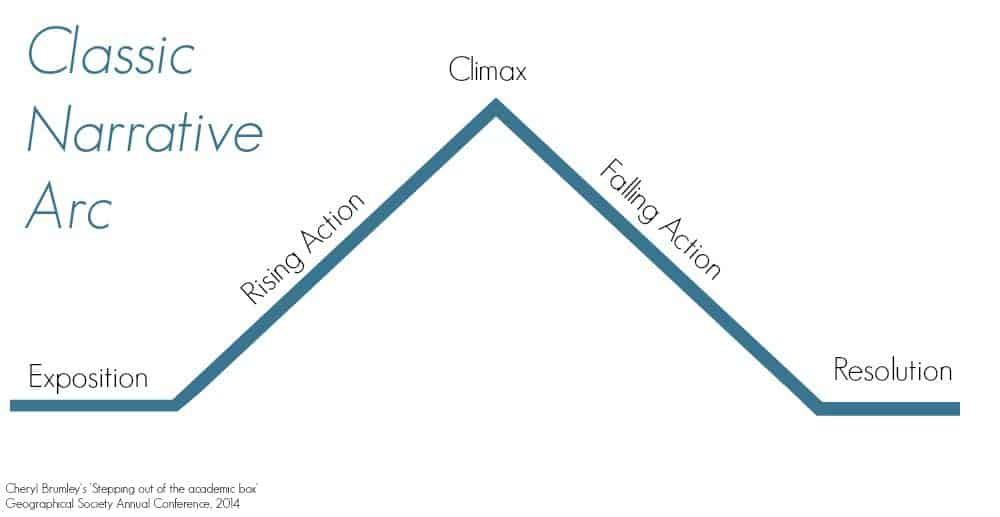
Frodo Baggins ended up going from a humble hobbit to a heroic figure that was able to overcome insurmountable challenges. He discovered he was much stronger and courageous than he first thought.
Stories inspire and engage people because they always touch on their humanity. We all know that deep down we have an inner power beyond anything we know.
CLICK TO TWEET: Stories inspire and engage people because they show we all have an inner power beyond anything we know.
The challenge and the resolution will help the reader position himself in the shoes of the character and see how he can also become a more successful, courageous, and powerful person.
Remember that the ultimate goal of your stories is to help people realize themselves and achieve their purpose. Add the three elements in place, and you will take your content to the next level.
What Does a Content Creator Do?
Content creation is a broad definition that encompasses every type of online media. A digital content creator can be a writer, like myself, a video producer (or a YouTuber), a social media influencer, a graphic designer, and more.
In this piece, I’m focusing on the type of content creation I specialize in. Obviously, I’m leaving to the side the other types of content creators mentioned before because I’m not experienced in those types of content.
The advice I chose to lay down in here can still be used by all freelance content creators alike, so if you’re not a writer, you can still learn a lot from these tips.
Get a Deep Understanding of Copywriting
Copywriting and content creation are two sides of the same coin.
Copywriting is related to generating sales—taking someone somehow interested in an offer and having them swipe their cards with excitement.
Content creation, on the other hand, is related to connecting with people.
As marketers say, copywriting is suited for “bottom of the funnel,” where people make purchases, whereas content creation is suited for the “top of the funnel,” where you engage with people.
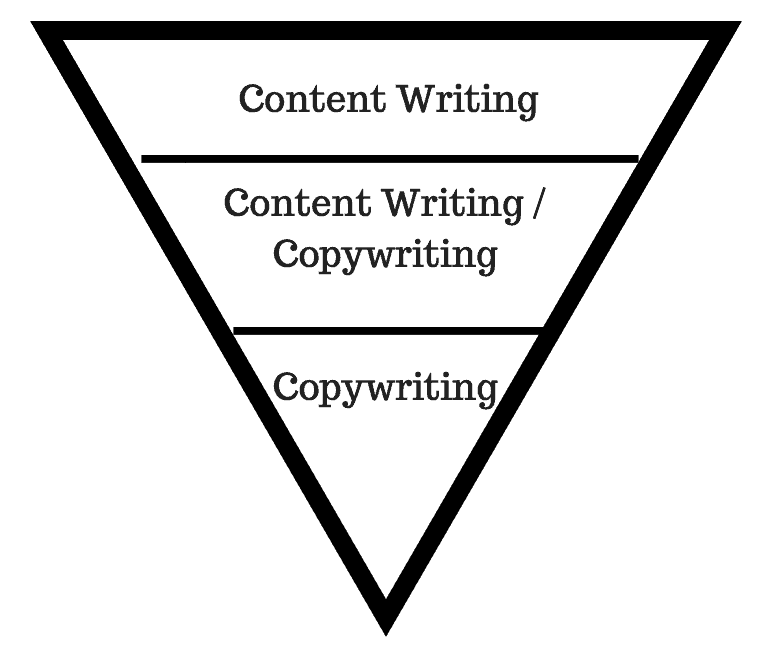
Within the online writing world, copywriters often see content creators as their silly, less-intelligent counterparts. Sure, they can write, they say, but they can’t make any money!
They think of a content writer as all talk, no action. There’s some truth to that, undoubtedly.
Discussions aside, copywriters have one skill content creators rarely have: the ability to understand human psychology and the art of persuasion.
In order to make a sale, a copywriter needs to get deep into the mind of their reader. All content creators—copywriters or content writers—need to understand their audience, but copywriters excel at being able to push the triggers that make people take action.
There’s no dark magic or manipulation involved; humans are simply imperfect, and copywriters know how to tap those imperfections—biases and heuristics, in psychology’s parlor—to make people gear towards their offers.
You don’t have to become a copywriter to get this psychological understanding. I do recommend, however, that you get a good understanding of these psychological triggers so you can use them in your content. You may not use them to generate a sale, but they will still serve you to connect and engage with your audience.
My recommendation is that you read copywriting sales letters and books on the subject because they will help you discover the tricks they use to achieve such results.
From the many copywriting books I’ve read, the best ones have been:
I also recommend you take at least one copywriting course, like the ones Joanna Wiebe, author of Copyhackers, sells. I highly recommend you take her course X because not only it will teach you how you can become “the most profitable person in the room” (in her own words), but you will learn how to think like a copywriter.
The process of learning copywriting will help you to:
- Understand the entire funnel, from top to bottom
- Develop powerful headlines that will catch people’s attention
- Structure a page to glue your reader’s eyes into your content
- Connect with the reader’s problems and needs
- Use trigger words—keywords that have a high emotional appeal in people
- Take people all the way to the cash machine, if that’s what your job entitled
Hands down, copywriting represents one of the key skills that will make you a much more versatile content creator.
The copywriting skills you acquire may remain silent, but that will make you a much more powerful content creator.
Extra: Learn the Art of Content Promotion
The job of a content creator goes beyond the writing itself. In a content-rich world where everyone and everything are fighting for your reader’s attention, you need to be as prolific at writing as you are at promoting your content.
I know many successful content creators who just write content. They can achieve success because, after hundreds of hours spent on writing high-quality content, people start to share it and promote it without the content creator’s intervention. I believe that’s a formula for failure.
It’s much better to be proactive and promote everything you write because, well, it makes your content get read more, shared more, and taken into action more.
Content promotion is an art on itself. The idea of sending a boilerplate email to random people to link to your article because “it’s better than that resource you linked in that post you published three years ago” isn’t promotion; it’s spamming (and acting like a douche).
If you consider most content pieces out there aren’t entirely read, then you can bet yours will also get ignored if you don’t promote it.
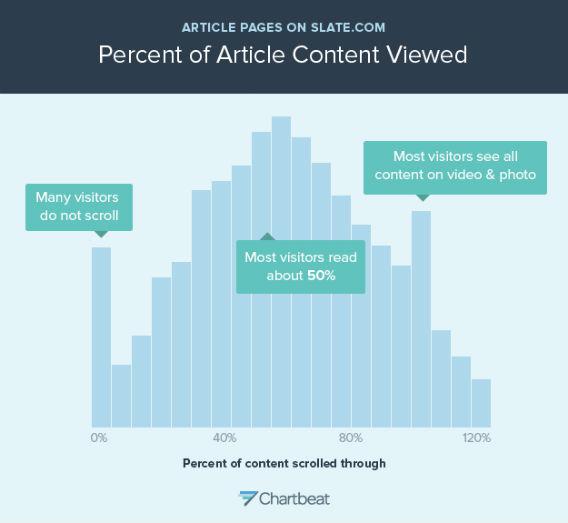
The promotion you carry out should be tailored to each piece, both before you publish it and after.
There are as many numbers of ways to promote a content piece as ways to skin a cat. Ask any content marketer and they will tell you they have their own patented content promotion process™, their own checklist, their own special prayers, and more.
In truth, there are just six ways you can promote a piece of content:
- Through the act of getting links to rank your content piece in the search engines
- Through the act of getting influencers (i.e., people with a lot of followers in different social networks) to share your piece with their audiences
- Through online communities, like Reddit and Facebook groups
- Through paid ads, like Facebook ads and retargeting
- Through your email list
- There’s no sixth way, thank you very much for reading 😅
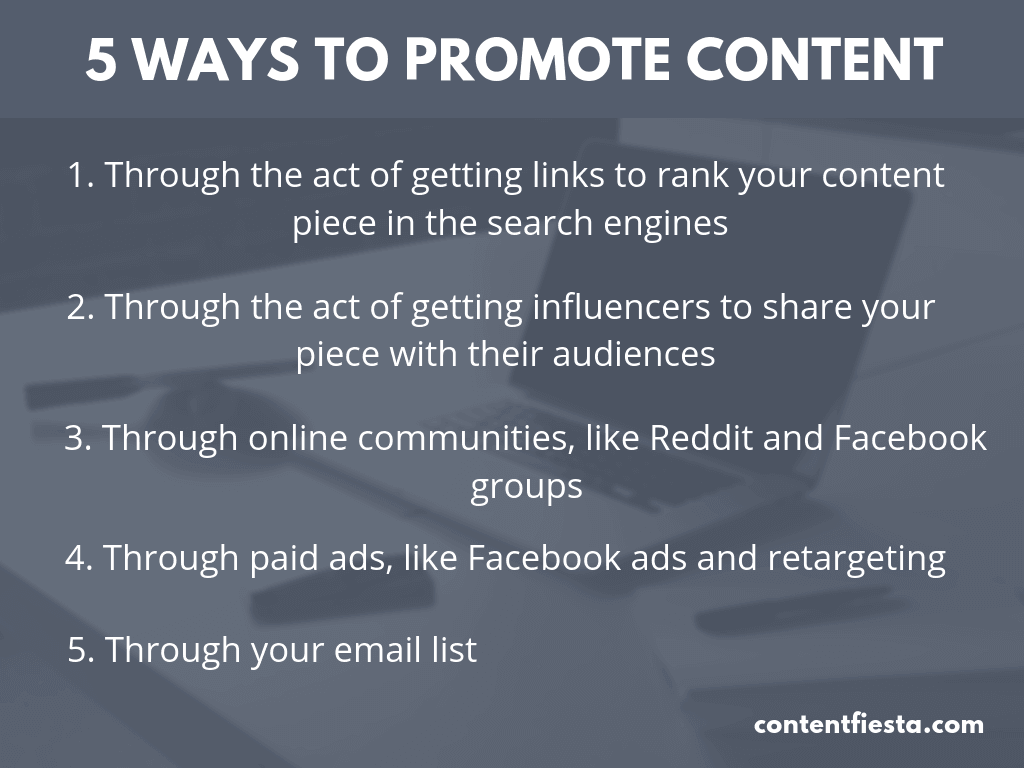
Any other unique way you find online is a diluted formula of any of the five ways mentioned above.
There are two points you need to consider when you promote a piece:
- Which of the five ways mentioned above you will use
- When you will use each one—before or after you publish your piece
More often than not, content creators start the promotion after they publish their pieces. They send emails, they tweet to people, they start a campaign in Facebook ads, and so on…but by then it’s too late.
The next piece of advice is something that you will thank me later for having shared it with you today:
The launch of your content promotion campaign should always start before you publish your content.
Whether you make a list of sites to outreach to ask for a link, you create a list of influencers or develop a simple Facebook ads campaign, you need to plan everything beforehand and start the development weeks before you hit the “Publish” button.
It takes patience. It takes foresight. It takes a strategic mindset. It takes tinkering with different tactics until you find one that works.
Worse yet, if you have no pre-established authority in your industry, it will take years for people to take you seriously. But you have to do it for every piece you create, even if that means sending a short email or a small tweet.
You have a responsibility as a content creator to promote everything you do, both for yourself and your clients.
You don’t have to because “you’re just a content creator.” But it will make you one that gets results.
You will get people to actually read your content.
The Best Freelance Content Creator Jobs
The first step to get a freelance content creator job is to define exactly what role you’d want to get. There are many different types of content creation jobs, including:
- Copywriting: Creators who specialize in creating copy to generate sales—also known as “direct-sales” content.
- Article writing: Creators who focus on writing articles that educate their readers on a given subject, often within a B2B industry. This is what I do.
- Journalism: Creators who specialize in interviewing people and researching a wide range of topics in depth.
- Ebook writing: Similar to the one above, these creators focus on longer, gated pieces formatted as ebooks. It can include white papers, which are more formal in nature.
- Ghostwriting: Creators who write for others. It often includes articles, ebooks, and book writing.
- Social media writing: Creators who specialize in formatting their content for social media networks, especially Twitter, LinkedIn, and Facebook. It may include ad writing for Facebook.
- Technical writing: Creators who specialize in translating technical concepts to non-technical people.
- Proofreading and editing: Creators who check and improve other creator’s content.
- Content management: Creators who specialize in managing a team of writers, formatting a piece for publishing, promoting it on online communities, and so on.
- Video scripting: Creators who specialize in writing scripts for videos. It can include explainer videos, tutorials, and more.
We can also categorize this long list of content creation jobs according to their type:
- Full-time.
- Part-time.
- Contract.
- Freelance.
If you are just starting as a freelance content creator, then I highly recommend you start with contracted and freelance work. That’s how I did it, and I recommend anyone to do likewise. It’s easier to learn how to create content this way than trying to get a full-time job with little experience.
Popular marketplaces like Upwork and Freelancer are common choices for freelance content creators at this early stage. While I don’t want to deny the use some find to them, they can be incredibly tiring. Low-paying jobs and stress abound. Why would you get yourself in so much trouble for so little?
In the past few years, I’ve tried new sites that provide the benefits of marketplaces without their problems. Some curate jobs, while others are focused exclusively on content. This means the clients available tend to be higher in quality than the $0.05-per-word type-of-client you see in Upwork.
The top three I recommend you check are:
SolidGigs
SolidGigs is a service that curates content creation jobs from all around the web and sends them directly to your email.
Since SolidGigs lists other company’s jobs, their value proposition lies in the curation, not the unique jobs they provide. In other words, you can find the jobs they list in other job sites.
But finding and tracking jobs in multiple marketplaces is tiring. SolidGigs solves this problem by sending them all to your email, thus saving you a lot of time.
They also say they only bring the “very best 1% of jobs available daily.” So don’t expect cheap or low-quality jobs.
Another thing I like about SolidGigs is that they are more than a job site. They provide nine courses around the topic of freelancing, including:
- Increasing your ability to win projects, by Nathan Allotey.
- Selling as a freelancer, by Bruno Padilha.
- Working with clients you love, by Ian Vadas.
The company also offers interviews with top freelancers, resources, templates, and exclusive articles. This has been the #1 reason why I’ve continued to use their service, even when I’m booked.
The quality of their service comes at a cost, however. For $19 per month, you get the content creation job curation service, plus the courses and interviews.
FlexJobs
FlexJobs is an online platform that helps freelancers find remote, freelance work, and part-time employment. Unlike other freelance platforms, FlexJob curates each job position before listing them on their site.
Besides being a freelance job marketplace, FlexJobs offers the following features to its members:
- Specialized job search checklists.
- Over 170 tests to assess and promote your skills.
- One-on-one career coaching.
- Resume writing assistance.
- Over 60 special member discounts, including WeWork, Audible, Grammarly, Quickbooks, and more.
- Thousands of articles, webinars with top hiring companies, and educational guides.
To apply for jobs, you need to create a profile that you can use as a professional-looking resume. You can also take skill tests and add those to your profile as well as any relevant work samples.
I used FlexJobs for some time, and I liked it a lot. On the one hand, it’s similar to SolidGigs in its curation-focused approach to job hunting. But on the other, FlexJobs is more focused on jobs for larger companies.
To use FlexJobs, you need to sign up for a paid plan. These are their current prices:
- Weekly: $6.95
- Monthly: $14.95
- Quarterly: $29.95
- Yearly: $49.95
I would recommend FlexJobs to anyone who has tried other freelance marketplaces and hasn’t had any luck. Their services, discounts, educational content, and curation will help any beginner freelance content creator find a great job easily.
ProBlogger
ProBlogger is one of the oldest content creation marketplaces. Started by Darren Rowse, this marketplace is simple in its nature as it doesn’t have any of the extra services SolidGigs and FlexJobs offer. In contrast with these other services, ProBlogger is way more focused on content creation jobs than the other two.
When I first started in my freelance writing career, I used ProBlogger to find some gigs. The truth is, most content creation jobs are cheap. You can find jobs that pay anywhere between $0.01 per word to $0.20 and beyond.
In ProBlogger, you can find jobs about:
- Copywriting.
- Content writing.
- Proofreading and editing.
- Video scriptwriting.
- Translation.
Since it’s free, I would recommend trying ProBlogger for any beginner freelance content creator looking for a job. They may not be that profitable, but at least they can help you get started in your career.
Best Full-Time and Part-Time Content Creation Job Sites
I know freelancing isn’t for everybody. If you are interested in finding full-time and part-time content creation jobs, I recommend checking the following sites:
- We Work Remotely: As the name suggests, this company focuses on remote jobs for larger companies.
- Wellfound: Focused mostly on tech startups.
- Indeed/Glassdoor: These are the most popular and famous sites, mostly focused on large companies and local businesses.
What’s A Good Freelance Content Creator Salary?
Salaries for content creators vary greatly depending on several factors:
- The experience—the more experienced you are, the more you make.
- The location—content creators who work from high-income places like the United States, Europe, or Australia make more than those coming from Latin America, Asia, or Africa.
- The city—for example, New York-based jobs pay more compared to ones from Tennessee, largely due to higher costs per living in the former.
- The type of content creation—copywriters can make more thanks to having a greater influence in the sales, while editors of writers
- The type of job—freelance and full-time positions can make more than part-time or contract-based ones, although that depends a lot on the skills of the creator to command higher rates.
To give you a ballpark estimation, Glassdoor shows us that US-based content creators make an average of $49,000 per year. There’s a significant variance in the distribution, with a large number of jobs in the $30,000 range, with a minority of $50,000+ paid jobs.
Payscale shows similar results, with an average salary of $43,000 per year, while most salaries range anywhere between $31,000 and $75,000.
Zippia shows better numbers, with an average salary of $55,000 per year. Salaries range between $34,000 and $91,000.
This analysis would require a more detailed look since the title “content creator” is not as common as other more specific titles, like “technical writer.” For the latter title, Glassdoor shows a higher average salary than for the former:
As a summary, I’d suggest you take the ~$43k-ish number as a good number to aim to if you have little to no experience. From there, your salary can vary a lot depending on the factors mentioned before.
Here’s How You Can Become a Great Content Creator
So there you have it, the five ways to become a freelance content creator.
It’s been a long article—over 6,000 words, as usual.
For that reason, if you want to get a summary of this article with all the action steps, download the following document for free. All you have to do is give me your first name and your email and you’re done.
🎁 Want the become a content creator? Download a summary of this article.
